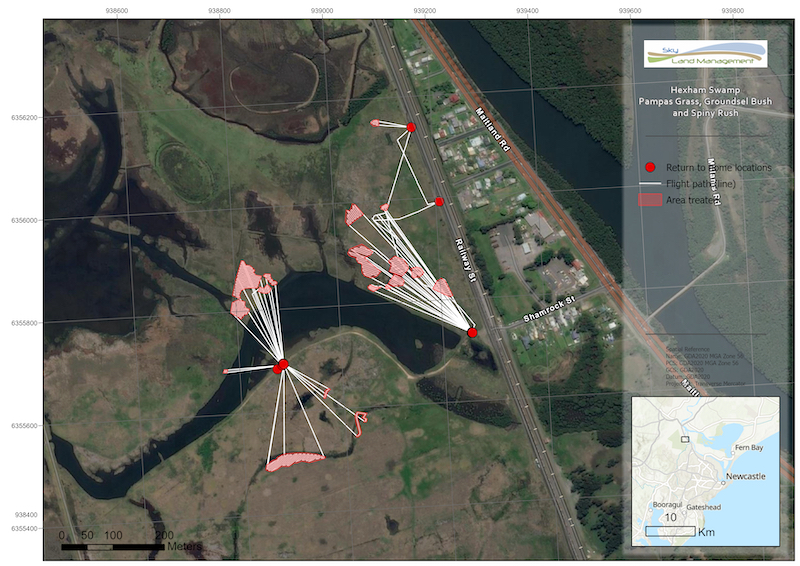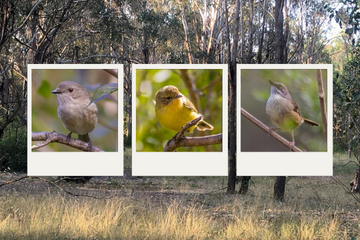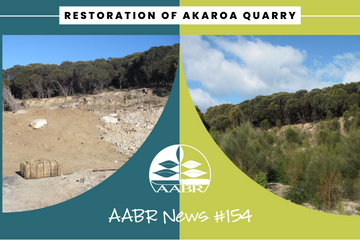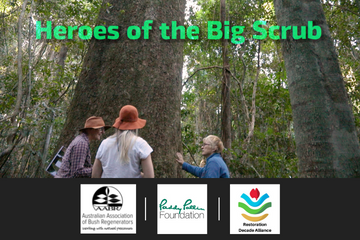Fig Top Left Part of the rainforest plantation at the private property owned by Jephcotts – 2006 (Photo Mark Dunphy); Fig Top Right. EnviTE map of the Big Scrub showing remnants, camphor and corridors (Map Paul O’Connor, EnviTE Environment)
The Big Scrub is an area of subtropical rainforest in north coast NSW on deep volcanic soils. Believed to have once covered 75 000 ha it was all but cleared, mainly for dairy farming, by 1900. Efforts to regenerate the remaining fragments and expand and link them with plantings have been ongoing since the 1970s, coordinated in the last two decades by Big Scrub Landcare (BSL). With assistance from BSL, the vegetation type is now listed as an Endangered Ecological Community at state level and Critically Endangered Ecological Community at federal level.
Works since formation of BSL in 1992. Alongside substantial funds that have been invested by private landholders (e.g. Figs Top Right), BSL has attracted more than $2M in grant monies over the last 20 years, over 80% of which has been invested in (mainly contract) regeneration works in the remnants and in replanting on both private and public lands (including seven nature reserves).
BSL Relationships now include 12 major institutional partners (including state and local government agencies), 60 landholders, 90 different properties containing remnant or regrowth vegetation and over 100 replanting sites
What has been achieved?
Regeneration. Most of the significant Big Scrub remnants (87% of the 68 remnants now listed) have been subjected to systematic rainforest regeneration treatments, showing substantial levels of recovery, increasing resilience and buying more time for the species within these remnants. Of these remnants, 31 are now on maintenance, with 28 sites still undergoing follow up works. This means that the threat of invasive weeds is being managed about 330 ha of remnants (over half the area of this habitat remaining. (Fig 1 and 2).
Fig 1 (a) Regenerators at work in Jephcotts stinger gulley 1992. (b) Recovering rainforest at the same site in 2006, 14 years later. (Photos: Mark Dunphy).
Fig 2. Quadrat 6 east, Johnsons Scrub prior to treatment in 2008 (b) just after spraying in 2009 and (c) regeneration of pioneers,18 months later in 2011 (Photos: EnviTE Environment)
The main weeds treated have been camphor laurel, lantana (Lantana camara), large-leaved privet (Ligustrum lucidum), climbing asparagus (Asparagus plumosus), ochna (Ochna serrulata), wandering creeper (Tradescantia fluminensis), madeira vine (Anredera cordifolia), tobacco bush (Solanum mauritianum), white passionflower (Passiflora subpeltata).
Replanting. Much planting is being carried out by landholders independently of BSL, so a precise figure is not possible. But an informed estimate is that approximately 900,000 trees are likely to have been established on Big Scrub sites – potentially involving about 250 ha. The goal is to include a diversity of trees species, matched to terrain, although only a few species are planted in frost prone sites until canopy cover protects the areas from frost. Because many species are naturally dispersed by birds and bats over time many plantations increase in diversity as more species are dispersed into the site by birds or bats feeding on the planted trees. (Fig Top Left)
‘Camphor regrowth’. While some increases in area and linkages have been achieved through the regeneration and planting works, capacity to convert farmland to rainforest is limited by a range of challenges.
A substantial contribution has been made, however, by regrowth containing both the tree weed camphor laurel and native rainforest species regenerating in tandem, facilitated by birds dispersing the seed of both. While camphor laurel remains dominant for long periods, these sites have proven amenable to conversion to rainforest by rainforest regeneration treatments.
The potential for camphor regrowth to make further substantial contributions encourages BSL to continue to hold continuous linkage between remnants as the long term aspiration. This is represented by a corridor framework developed by the group in collaboration with EnviTE (Fig Top Right).
Contact: Mike Delaney EnviTE Environment. Tel: 02 6627 2840 Mob: 0429 968 070. Email: miked@envite.org.au
regenTV
Watch the video of the short seminar presentation below. You also may be interested in other videos on AABR’s regenTV channel.









Leave A Comment